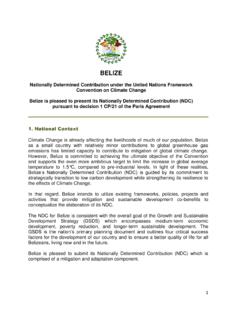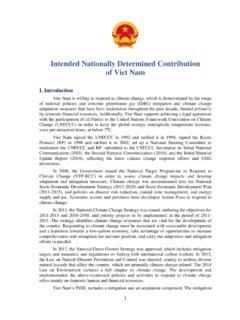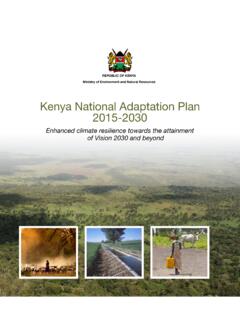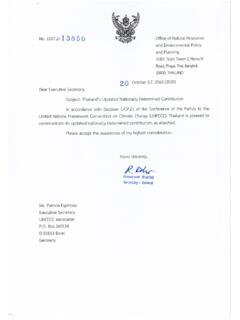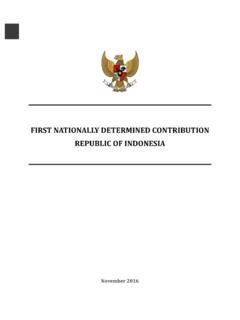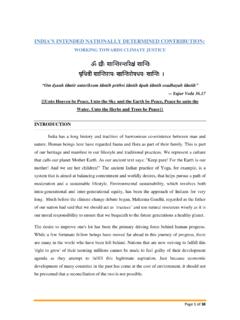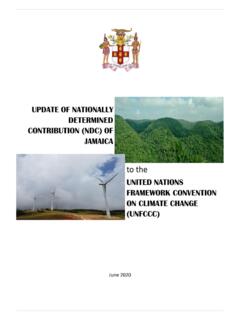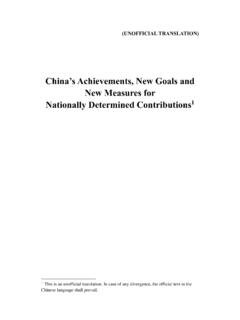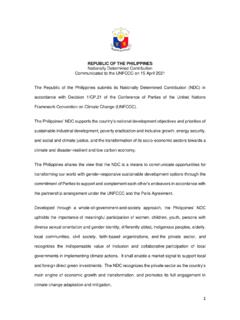Transcription of The United States of America - United Nations Framework ...
1 1 The United States of America Nationally Determined Contribution Reducing Greenhouse Gases in the United States : A 2030 Emissions Target 1 The United States Nationally Determined Contribution Reducing Greenhouse Gases in the United States : A 2030 Emissions Target _____ INTRODUCTION This submission communicates the United States nationally determined contribution (NDC) in line with Article 4 of the Paris Agreement. The Paris Agreement establishes a goal of holding the increase in the global average temperature to well below 2o C above pre-industrial levels and pursuing efforts to limit the temperature to C.
2 Climate change is an existential threat and demands bold action. Solutions exist today to reduce emissions rapidly while supporting economic growth and improving quality of life. Addressing the climate crisis requires scaling the many solutions we already have, while investing in innovation to improve and broaden the set of solutions, enabling multiple pathways to reach global net zero emissions. After a careful process involving analysis and consultation across the United States federal government and with leaders in state, local, and tribal governments, the United States is setting an economy-wide target of reducing its net greenhouse gas emissions by 50-52 percent below 2005 levels in 2030.
3 The National Climate Advisor developed this NDC in consultation with the Special Presidential Envoy for Climate, and it was approved by President Joseph R. Biden United States Historic Emissions and Projected Emissions Under 2030 Target 2 Deploying zero-carbon solutions in the United States will create good jobs and improve the health of our families and communities. Local air pollution reductions that come along with reaching this goal will avoid tens of thousands of premature deaths by 2030.
4 The United States is committed to standing with the workers and communities too often left behind people and places that have suffered as a result of economic and energy shifts and creating well-paid employment in the low carbon economy. The United States reaffirms its commitment to the creation of decent work and quality jobs as an integral part of its efforts to combat climate change. The United States will work to ensure that our firms and workers are not put at an unfair competitive disadvantage and cooperate with allies and partners that are committed to fighting climate change.
5 As appropriate, and consistent with domestic approaches to reduce United States greenhouse gas emissions, this includes consideration of carbon border adjustments in relation to carbon-intensive goods. Furthermore, acknowledging that the worst impacts of climate change have hit historically disadvantaged communities hardest, the United States is committed to environmental justice and to prioritizing investment that benefits these communities. In addition, American innovation will increase the diversity of available and accessible low-cost low-carbon technologies to eliminate greenhouse gas emissions.
6 The United States also notes the importance of natural climate solutions, terrestrial and marine, in climate ambition and resilience. It further recognizes the role of the broader suite of ocean-based climate solutions, including scaling-up offshore renewable energy and reducing emissions from shipping and ports, in increasing climate ambition and creating jobs. There are multiple paths to reach this goal, and the United States federal and subnational governments have many tools available to work with civil society and the private sector, mobilizing investment to meet these goals while supporting a strong economy.
7 The solutions are affordable, and the cost of inaction far outweighs the cost of action in economic and humanitarian terms. Based on preliminary estimates, the United States is expected to have met and surpassed its 2020 target of net economy-wide emissions reductions in the range of 17 percent below 2005 levels and is broadly on track to achieve 26-28 percent emissions reductions below 2005 levels in 2025. The 2030 target represents increased ambition made possible in part through advances in technology and resulting market responses.
8 A whole-of-government approach on climate action at the federal level will play an important role in achieving our target in 2030, building upon and benefiting from a long history of leadership on climate ambition and innovation from state, local, and tribal governments. Strong and predictable policy frameworks support private investment in innovation and deployment of carbon pollution-free technology and infrastructure, spurring markets that drive continued progress. All levels of government and the private sector will partner to drive and implement this NDC and create a more equitable, resilient, zero carbon future for the American people.
9 3 The National Climate Advisor and the White House Office of Domestic Climate Policy, in consultation with relevant departments and agencies across the federal government, conducted a detailed analysis to underpin this 2030 target, reviewing a range of pathways for each sector of the economy that produces CO2 and non-CO2 greenhouse gases: electricity, transportation, buildings, industry, and the land sector. Technology availability, current costs and available savings, and future cost reductions were considered, as well as the role of enabling infrastructure.
10 Standards, incentives, programs, and support for innovation were all weighed in the analysis. In addition to the techno-economic analysis, the National Climate Advisor and the White House Office of Domestic Climate Policy ran an interagency process across the federal government and consulted a range of other stakeholders, including groups representing: tens of millions of advocates and activists including environmental justice leaders; the unions that collectively bargain for millions of Americans who have built our country and work to keep it running; thousands of scientists.

